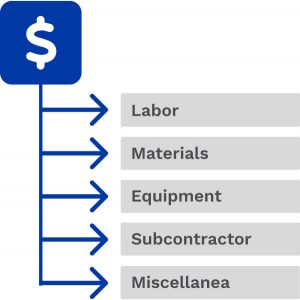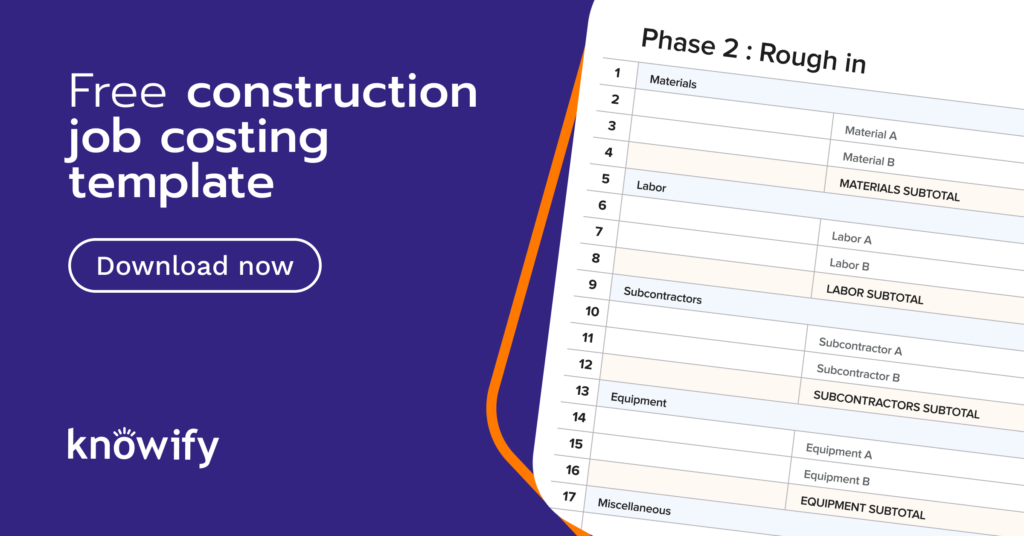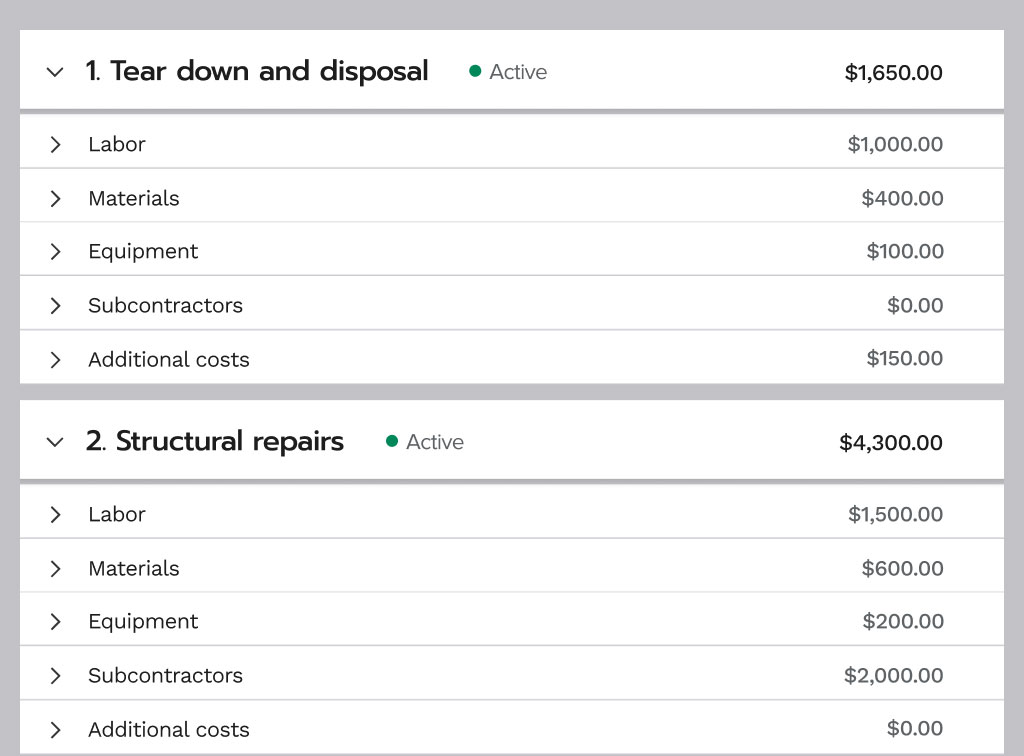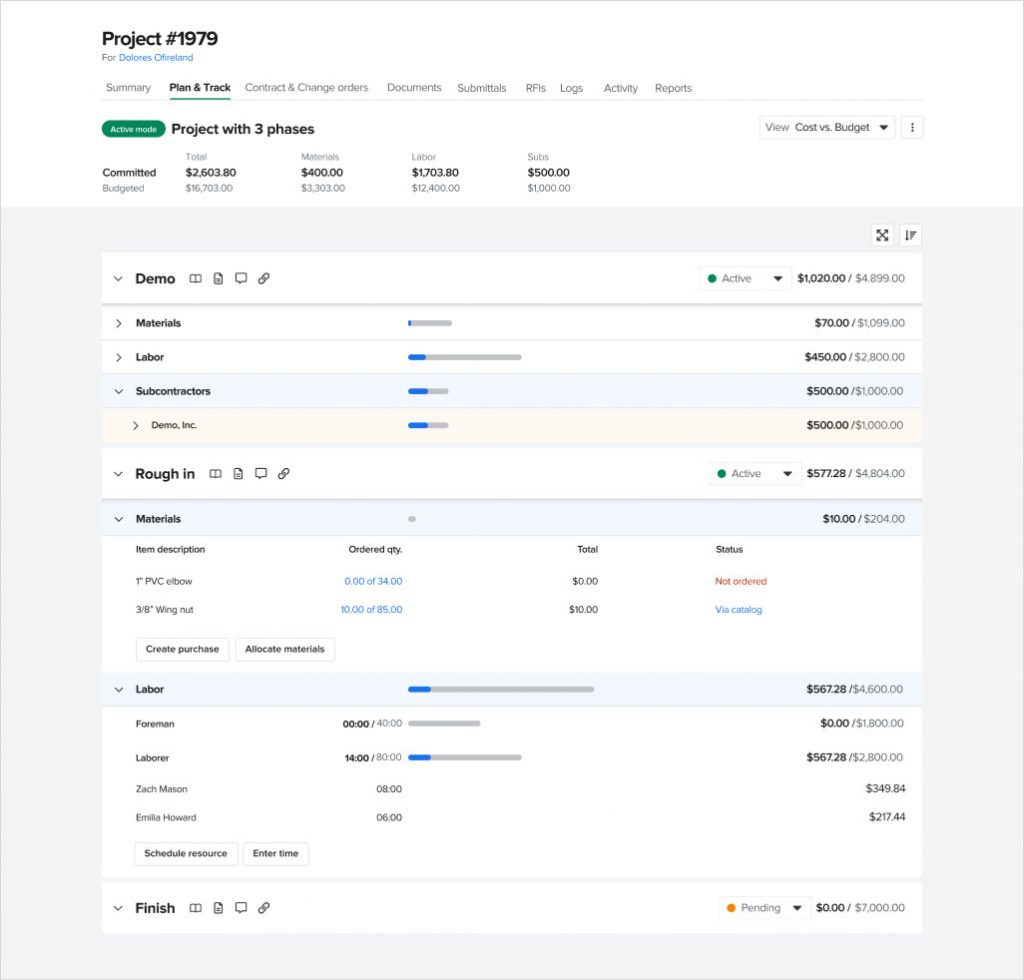As a business owner, ask yourself: do you know exactly how much money you’re making on each project and why you’re making that amount? Are you confident that you’re bidding as aggressively as possible without risking your margins? Do you know which of your crews are most and least efficient? Can you confidently generate a profit on every job? If you can’t answer these questions, you’re not alone.
Business owners from every trade grapple with gaining a true understanding of their business. You may feel that your business is operating at a healthy level–but are you confident that you’re doing everything possible to optimize and grow your business the right way? Chances are you’re missing opportunities to improve your bottom line.
It’s for this reason our guide for mastering construction job costing was created. Accurate job costing is crucial for effective financial management throughout a construction project. It helps in tracking costs, such as materials, labor, and overhead, not only for current budgeting but also for improving estimates for future construction projects. It’s our aim to showcase how job costing is the secret to answering nearly every question you have about your business.
84%
of firms report construction costs have been higher than anticipated
17.5%
increase in overall construction costs in 2021
74%
of contractors say they are asking skilled workers to do more work
69%
of owners say poor contractor performance is the single biggest reason for project underperformance
Source: Autodesk construction blog
What is job costing
Job costing in construction is a method for tracking both the direct and indirect costs of specific construction projects. It’s primarily done for two reasons:
- To identify how much money you’re making (and will make) on a particular job.
- To better understand precisely where and when you’re making or losing money.
You do this by tracking costs for a particular job at a granular level, broken down into five main categories:

Consistently tracking project costs will allow you to build a historical data set to evaluate job performance and to reference when budgeting for future projects.
Job costing is not to be confused with other forms of job-level accounting, such as process costing. Accounting methods like process costing are best suited for manufacturers producing identical products or services on a large scale. It evenly averages out direct costs over the number of units, making it a more general approach to pricing.
Although averaging costs across multiple jobs for estimating and bidding purposes may seem convenient, it lacks the necessary level of detail to accurately evaluate job success. For this reason, job costing is the principal method for construction companies to evaluate job-level performance.
If using job costing software, your ability to evaluate data and make better decisions will be enhanced even further. With real-time cost data coming in, you can see immediate project performance, meaning you and your team can adjust your spending or project plan on the fly to optimize profitability. Consistently tracking project costs will allow you to build a historical data set to reference when budgeting for future projects.
For example, looking at this data over time, you may see that you actually don’t make enough money on a specific type of job. While this is valuable information, effective job costing shouldn’t stop there. Digging deeper, you’ll be able to see where and why you aren’t making money. Perhaps it’s because you’re overspending on labor for a specific task. Or you may see material costs are consistently over budget causing your overall margins to dip.
Equipped with this information, you can uncover new opportunities to be more cost-efficient on that type of job. Or you may stop bidding on those jobs altogether. It’s only through building a historical data set, that you can generate better estimates, and from those estimates, you’ll have a better sense of what types of jobs you should target for maximum profitability.
In short, contractors can use job costing for better estimating, improved decision-making, and increased profitability.
What to track
Labor costs
Project profitability depends on how well you estimate labor costs within the project budget. It’s also one of the trickiest aspects for a business to get right.
Costing labor begins with the following questions:
- Which person did the task/job?
- What is their wage?
- How many hours were they working?
Answering those questions is a great starting point. But you’ll need to take it further: it’s crucial you account for your “all-in” labor costs by applying the appropriate labor burden. Labor burden includes but is not limited to:
- FICA
- State Unemployment tax
- Health/Dental/Vision or other such benefits
- Retirement Contributions
- Workers’ Comp
We can’t stress enough how important it is to account for labor burden. If you don’t account for your total labor burden, your job costing could be off by as much as 50%. Leaving out labor burden is a common flaw amongst first-time job-costers, that results in profit on each job appearing much larger than it actually is. Don’t let this mistake put you out of business.
In the next section we’ll show you how to track labor costs with fully burdened labor costs included so you can avoid this common pitfall.
How to track labor costs
If you’re not sure where to start in regards to labor burden, reference your payroll reports. There, you should be able to find not only the hourly wages you pay (which you probably already know) but also taxes, unemployment insurance, and other fees you pay via your payroll provider.
Next, check your workers’ compensation and health insurance plans. Those two items can be significant cost sources, and you’ll want to ensure you’re capturing those costs in your job cost reports. Remember: to convert an annual number into an hourly one, divide by 2080; for a monthly one, divide by 171.
Let’s work through an example: Fred makes $15/hr and works, on average, 40 hours a week. Given your trade, Fred’s workers’ comp rate is $15 per $100 he makes (so, 15%), and Fred’s health insurance costs you $600/month. So, while Fred’s wage might suggest that he costs you $15/hr to have working on a job, in reality, Fred’s hourly cost is:
| Wage | $15.21 |
| FICA | $1.15 |
| California unemployment insurance | $0.21 |
| Workers’ comp | $2.25 |
| Health insurance | $3.51 |
| Total | $22.12 |
So, in the example above, Fred costs 50% more than just his wage! You can see why capturing labor burden in your job costing is so important.
If the above sounds like too much work, you can also use a general best practice of estimating burden at 24%-50% of wages. This percentage can range even higher; for union contractors, for example, burden rate can be as high as 60-70%.
Once you’ve been job costing for some time, you’ll be able to analyze your labor costs across jobs to see which individuals or crews are most efficient. It may not be a general effect; instead, you may discover that specific individuals or crews are more efficient at certain jobs, leading you to change the way you schedule. Small business insights like this — and the business changes that come with them — can significantly affect your long-term profitability.
Material costs
Factors influencing material costs include:
- Quality of materials used
- Market rates
- Supply chain costs (manufacturing, shipping, etc.)
Tracking material costs can be tricky as costs will fluctuate on a job-by-job basis for several reasons, including job size, market rates, and quality. While you can’t generalize material costs across all jobs, you can use historical data to see how much you typically spend on materials for your most common type of job.
Every trade will have a seemingly infinite number of materials to keep track of. Painters, for instance, will have brushes, rollers, tape, patch, etc. Are they to track each and every one of those materials? This depends.
Most contractors who have not adopted digital solutions such as timesheet software, invoicing tools, or document management systems, just to name a few, don’t have an easy way of tracking all relevant material costs. This can lead to frustration and even stop some contractors from job costing altogether. Digital tools can go a long way in simplifying the way you tack materials, especially if your trade requires a large quantity of certain or multiple material purchases.
With that said, what’s important is that you track materials at all. How granular you get, and what materials you decide to track is up to you and your business needs, but you must account for material purchases in your job cost reports.
Moreover, since 2020, 83% of construction materials across the industry experienced a cost increase. The need to have your finger on the pulse of your material costs has never been more critical.
How to track materials
Let’s start with an example looking at a specialty contractor who primarily works with concrete. This contractor has a specific job every week with a similar scope of work with identical project details. With the regularity of this job, they can determine that material costs should be 20% of the total budget.
Given this information, they can make nuanced decisions throughout the job. If material costs for this job exceed 20%, they can make cost-saving measures in other areas; and use this information to create a better estimate for future jobs.
Material costs will be particular to the type of trade and work performed. Nevertheless, tracking and evaluating materials costs is a critical piece of the puzzle when job costing.
Equipment costs
To properly account for equipment costs, business owners must record ownership and operating costs.
Ownership costs
- Depreciation
- Insurance
- Taxes
- Licenses
Operating costs
- Fuel
- Maintenance
- General repair costs due to wear and tear
Equipment leasing costs
- Owned or capital leased equipment
- Operating lease equipment
- Rented equipment
Taking into consideration the original cost of the equipment, estimated years of useful life, and repair costs, you can determine an annual cost rate.
With this number, you can then factor in the estimated annual hours of use to calculate the equipment’s estimated standard hourly rate.
Subcontractor fees
Even as a subcontractor yourself, hiring additional subcontractors can save money and allow you to focus on your strengths, avoiding tasks beyond your capabilities. Just be sure to assess the necessity of their services for meeting project deadlines before reviewing any bids.
If you plan on bringing on additional subs, include those costs in your budget planning. It’s important to separate these costs from other categories, rather than spreading them out or adding them on top of other costs.
Follow the same procedures you’d want if you were in their shoes. This means you should be communicative and respectful of their time and trade. In addition, always craft a subcontractor agreement and get signatures from all stakeholders before any work starts.
Overhead costs
Overhead costs consist of costs you must pay to keep your business up and running, including rent, property tax, insurance, licenses, and permits. Should you include overhead costs when you calculate job costing? No, you shouldn’t. The reason why?
Overhead costs will not help you plan for the future. As a business, you’re trying to understand job level margin. If you obfuscate that by adding in overhead costs, you will have no idea what impact job-level profitability is having.
Think carefully about what is an overhead cost and what is a job cost. If it’s a job cost such as material or labor, include it. If it’s true overhead like office space that you lease, DO NOT include it in your job costing. The focus of job costing is on improving profitability on a per-job basis. Overhead costs will not help you do this.
How to job cost
In essence, job costing starts with tracking a job’s five main cost categories (direct costs): labor, materials, equipment, subcontractors, and any other costs (indirect costs).
Now that we know what metrics to capture, let’s look at how to start job costing at a beginner level, followed by a more comprehensive phase-based level. For each level, we will break down how to track actual costs at the job level and introduce where and how to budget.

Job costing for beginners
No matter how large or small of a project it was, at the end of the job, you can arrive at a total cost for each category of the job:
- Total cost of materials
- Total cost of labor
- Total cost of equipment
- Total cost of subcontractors
- Total miscellaneous costs
You can then use each cost to understand the overall cost of the job and compare that to the revenue you collected. From there, you can see where you made your money. Ideally, you would have determined a budget at the start of the project.
Comparing costs, to revenue, to your budget will start to give you a sense of how you’re performing against your expectations. You can track at this level and, at the very least, be able to tell how much money you made on that job.
The idea is to start capturing basic costs at the job level to build a historical data set to understand job profitability. The most significant advantage of this level of job costing is that it’s straightforward and accessible. As you will see later, though, it will not tell you the whole story.
What are the limitations? You’ll know what the numbers coming in are, but you won’t know why. You will not have all the information you need to problem-solve all cost increases effectively.
Especially for medium or larger-sized projects, you won’t understand exactly why you went over budget. You won’t understand the full story unless you get more granular with your tracking and budgeting.
While it’s not required to budget at this level of job costing, we strongly encourage you to start every job with a detailed budget. If you don’t start with a budget, you will have nothing to review and compare those costs against.
At more advanced levels of job costing, budgeting becomes a crucial component for problem resolution. We’ll explore the role of budgeting in our section on phase-based job costing below.
Phase-based job costing

Phase-based job costing will start with tracking the five main categories again; only this time, you will break each job down into phases and track costs against each phase. What is a phase? A phase is any major unit of work within the overall scope of a project.
A phase will consist of various tasks. You can choose to combine these tasks into subcategories that help you break down all work that you need to perform even further. You’ll use each phase as a mini-budget for the job, allowing you to get more specific with your evaluation and resolution through job costing. The idea is to treat each phase as if it were its own job.
For example, a plumbing contractor could have a job broken down into three phases: Groundwork, Rough-in, and Trim-out. For each phase, you can now track labor, materials, equipment, subcontractors, and miscellaneous costs. Doing so makes it much easier to identify where and why cost overages occur.
If your labor for a job came in 10% over budget, what specific phase or phases caused it to come in over budget? Are you over on costs because groundwork took longer? Was it because the trim-out took longer? This is valuable information because it is doubtful that all costs went over budget across all categories (i.e., labor, materials, equipment, etc.). It’s much more likely that a couple of specific aspects within a single phase caused the overall cost to come out ahead.
You can then use this knowledge to make adjustments as needed as the project progresses, or more importantly, you can use this data to change how you estimate and bid on future projects that will require a similar phase. With costs broken out at each phase, you can clearly evaluate cost overruns and overall job performance while the job is underway.
This method does require significantly more time in preparation and evaluation than if you were to just track at the overall job level. As we have shown, however, you get significantly more data. Phase-based job costing allows you to dig deeper and understand exactly where you are making or losing money, especially when comparing against a predetermined budget.
Phase-based job costing is key for increasing the profitability of future construction jobs. For example, if you find that the demolition phase of jobs tends to have the same process and costs from job to job, you can make note of this and apply those costs to future jobs.
Cost codes
The value of cost codes is for contractors who wish to standardize and report across jobs. Consistency in phase naming using cost codes could be very valuable, depending on your trade. Not every job broken down at the phase level will have cost codes. However, you can choose to use them if you want to get more granular or cost out similar phases across jobs.
Cost codes are a particular way to conduct phase-based job costing in which you always use the same numerical code for a certain kind of phase. For example, using the official CSI codes, plumbing piping insulation will always coincide with a code of 22 07 19. You’ll rarely find companies using their own custom cost code outside the official CSI codes, so if you use them, stick with the industry standard codes.
Budgeting with phase-based job-costing
| Phase | Labor | Materials | Equipment | Subs | Misc. | Total |
| 1. Tear down and disposal | $1,500 | $300 | $200 | $0 | $250 | $2,250 |
| 2. Structural repairs | $1.000 | $500 | $300 | $2,000 | $0 | $3,800 |
| 3. Assess the electrical and mechanical systems | $350 | $50 | $0 | $0 | $0 | $400 |
| 4. Assess the plumbing | $350 | $50 | $0 | $0 | $0 | $400 |
| 5. Flooring installation | $5,500 | $3,000 | $200 | $0 | $150 | $8,850 |
| 6. Install counters | $3,500 | $1,100 | $250 | $0 | $200 | $5,050 |
| 7. Backsplash installation | $850 | $250 | $0 | $0 | $75 | $1,175 |
| 8. Appliance installation | $650 | $50 | $0 | $0 | $0 | $700 |
| TOTAL | $22,625 |
Starting with a well-thought-out budget is a crucial component of phase-based costing. Instead of using an overall total for budgeting, you will now create a budget for each phase. It’s important to note that when budgeting at the phase level, you shouldn’t just look to get a total cost for the phase.
Instead, you should set a budget for each category within the phase. What is your budget for labor or materials in a particular phase? Budgeting gives you a starting point for job costs from which you can apply markup that will impact your overall margin on the job.
It will also give you a number to track against as you perform the job to understand your inefficiencies and whether you will make more or less money on the job than you initially thought.

In the example above, we’ve created a budget at the phase level: we can see that under the rough-in phase, we budgeted $204 for materials. We have also started job costing against it. We can see this because we have spent a total of $10 on ⅜ wing nuts. Since we started with a budget, we can now explicitly see how we track against our $204 budget.
We can also see we created a budget specifically for labor ($4,600.00). As the job progresses, we have accounted for $567.28. Again, this allows us to see how we are tracking against our budget for labor.
Starting with a budget helps us monitor spending on a job while it’s underway so we can make adjustments as needed. It can also help us see if we are behind on a project. Once you’ve completed all phases and the job hits substantial completion, you can go through your budget and analyze how each phase impacted the total cost of the project.
WIP & job costing
By now, it’s evident how valuable job costing is for reviewing past performance, but what can you do to evaluate a job in progress? You may wonder how much you should bill your client on their next progress invoice (where applicable).
One accounting concept that answers this question is Work in Progress, also known as WIP. Work-in-progress accounting, often used over long-term projects, summarizes the monetary value of work completed but not yet invoiced.
You’ll be able to determine if you are over or under-billing on jobs, which can help you forecast the upcoming cash flow of your company. This is another advantage of starting with a detailed budget before a job, as you can only gain value from calculating WIP if you start with a budget.
To calculate a WIP value for your project, you’ll need two things:
- A fixed price contract
- A budgeted cost
From there you can use the following WIP formula:
- WIP = ( Actual cost / Budget cost ) x Contract value – Billed revenue
Calculate Percentage of Completion by dividing Actual Cost by Budgeted Cost. This indicates any progress made against your budget. Why is this useful? Because you can use it to identify if you’re ahead or behind on billing. To determine the appropriate amount to invoice, multiply this percentage by the Contract Value.
Then subtract any revenue that you’ve already billed so that your WIP number only reflects what is still owed to you. A negative WIP means you’re over billing. A positive means you’re underbilling. In other words, overbilling occurs when invoicing exceeds completed work, potentially increasing cash flow but it can possibly lead to a cash shortage later in the project. On the other hand, underbilling involves completing more work than invoiced, resulting in negative cash flow.
Knowify simplifies job costing for trade contractors
As a business owner, you need to know the how and why of your construction company. The reality is that there are certain areas of every trade that are more or less competitive, and there are certain areas where you’re better than the competition. It’s an essential process that requires construction accounting software for optimal results.
Construction job costing helps you identify these areas so you can lean into them and build your business pragmatically and profitably. Thankfully, getting started with accurate job costing is simple and inexpensive.
Using software built specifically for construction companies like Knowify will give your business the tools you need to develop accurate job cost reports for every job. It’s our mission to help you grow job-level profitability. Which is what job costing for construction is all about.
Schedule a 30-minute demo with Knowify today. Seeing is believing, and we’ll show you a paperless, efficient, and robust digital future for your construction business built on effective construction job costing.
